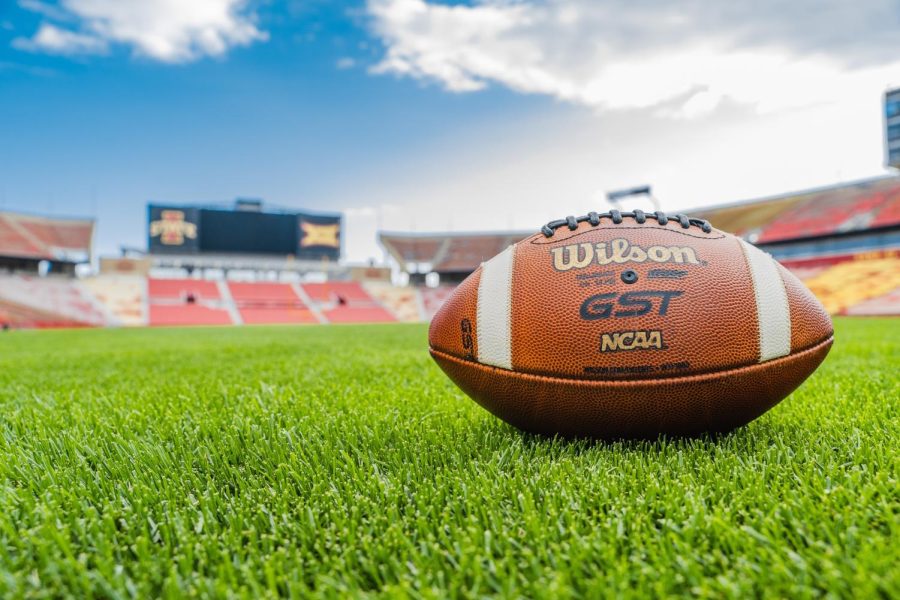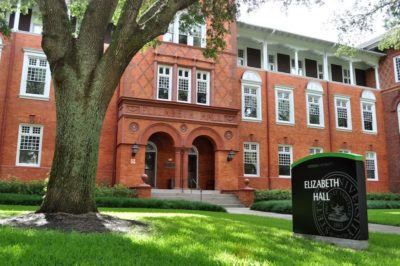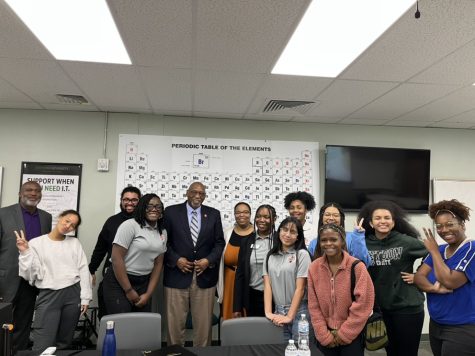Sports Game Fans…Or, the Lack of Thereof
At Stetson, sports fans have never disappointed as green clothes and cowboy hats conquer any sliver of pride that might have once built their fashion closet. Though, as the years go by, Stetson seems to have a lack of attendees at sports events.
The presence of fans in the stands is what makes a sports game complete. They stand on the sidelines with their flamboyant merchandise of funky glasses and beaded necklaces, donning their teams’ sports jerseys or decorated shirts. Even if someone was not a fan of the sport, no one could deny the adrenaline rush of being at a sports game, screaming and jumping at the competition happening below. At Stetson, sports fans have never disappointed as green clothes and cowboy hats conquer any sliver of pride that might have once built their fashion closet. Though, as the years go by, Stetson seems to have a lack of attendees at sports events. Even as the COVID-19 pandemic comes to an all-time low and restrictions become practically non-existent, stands at games do not seem as full as they should be. So, why exactly is there a lack of students at sports games?
The COVID-19 pandemic created an unusual situation that took away many of the spirited traditions that brought Stetson sports games to life. Tailgating, for instance, is barely making a comeback this season due to past pandemic restrictions, which was one of the contributors to the lack of students at games. Tailgating is expected as the long-held pre-party tradition that gets everyone hyped before a game. That ticks one off the list, which brings us to the next reason: the ghastly seating sections. Anyone who has ever gone to a Stetson football game, you are pretty much expected to sit on the grass-inclined Hatter Hill. It certainly does not help that one can almost feel as if they would roll right into the game of bustling players below because of the abnormal slope. It’s old news that Stetson did not seem to read and take the hint about, but recently there has been a new development: faculty is in the works of having new and improved student sections very soon.
Even with the coming resolutions, how can one undergo what a game is really like and have the true complain-about-all-things-wrong-about-Stetson-games experience if they cannot figure out a way to get there in the first place? Spec Martin Stadium is where Stetson football games are held, but the place is far enough from campus for a student to feel the need to drive and not walk. Though, with driving comes the wretched nightmare of parking. No one wants to pay the $20 fee for close parking for one game, so many students opt for the free parking, which usually follows up with the eight to ten minute walk to Spec Martin Stadium.
“I was talking about doing the buses again, because it’s already hard to find parking,” said Alijah Santos ‘23, executive director of Hatter Productions. “If a student happens to have a vehicle, that’s another concern – they would have to find parking before they can actually get to the game.”
The whole situation has me flabbergasted. It is like going through the pain of attending a major league sports game such as an NFL or NHL game. So, why on earth has this situation been happening for so long at an undergraduate university? The idea of having buses would definitely be ideal, “But if you get the buses, it completely overcomes both obstacles because it gets into transportation, and they also don’t have to worry about parking. You know?” Santos stresses.
Yes, students who do attend games do “know,” but not all Stetson University students have had the privilege of experiencing such an adventure. This is not even a concern regarding the environment of a sports game, but rather the question that circles around: wait, there was a game yesterday? To answer the question, there was a sports game yesterday… And the week before there was one as well. Many students seem to not have a knowledge of where or when a sports game is, which is a huge marketing and advertising issue altogether regarding athletic events. The social media pages that Stetson has up are not enough for students to realize that there’s a game, and even if it does, the game is already over.
Ariana Motta ‘23, the president of Student Government Association, shared her frustrations. “Personally, I just don’t hear about them enough. And I follow sports Instagrams and stuff. But I don’t use social media that much to the point where I’ll see it show up. And when I do, it’s already too late,” Motta said.
Similarly, Santos echoes the sentiment. “That’s really the big thing. I just don’t know when or where most of these games are happening,” Santos said.
With the lack of information of when and where games are combined with the athletic game environment, comes a decrease of fans in the stands at sports events. Though, this doesn’t just affect the school spirit at Stetson, it takes a toll on athletes as well. If we really want to get science-y here, there is actually a psychological concept for it: social facilitation. This refers to a change in a person’s performance that occurs when others are around compared to when a person is alone. According to Scientific American, top-of-the-line athletes tend to perform better with a crowd than when alone, while lesser competitors falter. They explain, “Not having in-person fans impacts the home-field advantage, a statistically supported phenomenon.”
Here at Stetson, soccer athlete Alexa LoBasso ‘24, gives her opinion on the phenomenon. “I think that, at times, it can have an impact on athletic performance. If people were to cheer us on more, like on the sidelines and stuff, then we would get really hyped and play better. They [opponents] would have everything against them, and our team would have everything going for them,” Lobasso explained.
The support that fans give at sports games is essential to the livelihood of athletics. Imagine teams playing during an event with no one there—an empty stadium, with no colors or crazy theatrical behavior brought by fans. It would be so quiet that all one would be able to hear would be the swearing of coaches on the sidelines and the running of players on the field. An athlete relies on the support and encouragement fans bring, and the work they put in day after day is not worth it if no one is there to support them. As a matter of fact, many Stetson athletes expressed to SGA at the beginning of the semester that they wished students were at their games. They continued to say that a lot of their motivation to perform better comes from having fans in the audience.
With the issue brought up directly by the athletes themselves, SGA began to turn their focus on the matter. Their bottom line is figuring out how to bring students to games, or more specifically, what would make students want to attend the events. “When we looked at ways to initially find solutions to this, we thought about bringing back a reward system for students to earn points in prizes for coming to games. We also looked into creating an additional app out there that centralizes all the information regarding sports,” Motta states.
Both ideas sound promising as they address the needs and wants of Stetson students to bring them towards the athletic events. Now is the most pivotal point where SGA can make real change for students and athletes because they are now gaining an insight of the big areas they need to focus on. Recently, an NCAA athlete was voted into the SGA senate, which will give the association the opportunity to address the concerns athletes have more often and personally. The dilemma athletes expressed did not just reach SGA, but it also reached Stetson Athletics as a whole. A few weeks back, some of the directors of athletics came and spoke to SGA, and presented the hurdles they were facing.
Associate AD for External Operations, Heather McCormick, is a part of the team that is working towards the predicament, and was also in attendance at the SGA meeting. “We’re reaching out across campus and looking at what we can do better. And we are listening to students, and we really want students involved in not just the feedback, but also the process,” McCormick stated.
Her and her team are fairly new to Stetson—McCormick herself started in March. This brings promise that was not there before—to know that there are now new people in the external operations department that truly recognized the problem of the lack of students at sports games. The concerns that have been raised by athletes and students have reached their department, and the enlightenment that they have been receiving has been laying out ideal resolutions to the table. For fans, they have brought up the idea of resurrecting a Varsity Club here at Stetson, which would be wholly devoted to creating school spirit at the university.
McCormick adds, “And how perhaps, out of the varsity club membership, we could create a committee that could be dedicated to the Mad Hatter’s, which is our students section. And, you know, that group could assist us and partner with us in distributing information about athletics and also be a constant source of feedback so that we’re making students excited about coming to games.”
External operations has the goal of enforcing the Varsity Club and having it in place by next fall, which is definitely a step in the right direction. Gestures, concerns, and complaints are freely welcomed by External Operations and SGA—the more feedback that students give to these departments, the more they can recognize and focus on what specific areas they need to solve. There is an entirely new team at Stetson to address the lack of students at sports games, and to do whatever they need to do to enhance the student experience for fans, which in turn, betters the athletes on the field as well.
There is a reason the camera angles of televised sports games often include a section of the stands. Stetson athletes could either win or lose a game, but it doesn’t matter if there’s no one there to watch them succeed or fail. The comments on YikYak that congratulate the winning games or that shame the losing ones don’t substitute for the lack of students at the games. There was a point during the pandemic where cardboard cutouts of fans were placed in the stands to soften the disappointment of seeing them empty. Regardless of what might be missing from games for now, Stetson and associations such as SGA are working towards change that will fill the stands to the point where the need for additional seating would become a frequent complaint once again. Though, if anything, there is always the simple solution where Stetson could easily invest in cardboard cutouts to help the athletes out on the field.


















